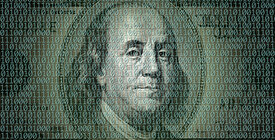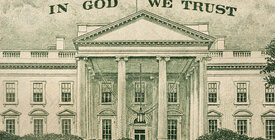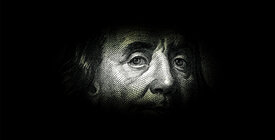Types of Dark Money Spending
The term dark money as used in this analysis refers to election spending and contributions by nonprofits and shell companies that are not legally required to — and do not — disclose the identities of their donors. The lack of transparency does not make the spending analyzed here illegal, although the Brennan Center supports legislation to require full disclosure of more of it. Dark money flowed into the 2024 elections in four ways that can be tracked: contributions to super PACs, direct spending reported to the FEC, TV spending, and online spending.
Contributions to Super PACs
During the 2024 election cycle, shell companies and 501(c) nonprofits that did not disclose their funding sources gave $1.3 billion to super PACs — more than in the prior two election cycles combined.
Citizens United and later court cases led to the creation of super PACs, which can receive contributions of any amount, including from corporations and unions. Although super PACs are supposed to operate independently from the candidates they support, many are established by candidates’ close allies or run by former staff or party operatives. Many share consultants with campaigns and even enlist candidates to help them fundraise.
Recent FEC rulings have opened the door to even more direct cooperation between candidates and super PACs in certain critical areas — including canvassing and get-out-the-vote efforts. Donald Trump’s 2024 campaign outsourced many of these activities in swing states to a super PAC run by his largest supporter, tech billionaire Elon Musk, while Kamala Harris leaned heavily on a super PAC run by Democratic Party operatives.
Super PACs are required to report their donors, but they can easily hide the original sources of their funds by taking money from dark money groups. This practice has exploded in recent elections. Many of the top-spending super PACs in 2024 — including Future Forward USA, which worked to elect Harris, and the Senate Leadership Fund, which is tied to Republican Party leaders — had affiliated dark money groups that provided eight- or nine-figure sums.
The chart below shows how dark money has evolved since 2010 according to FEC data. Direct ad spending by dark money groups used to be the main reported funding avenue, but its 2012 peak is now eclipsed by dark money contributions to super PACs in each of the previous three elections. (For the purposes of this analysis, the term super PACs includes groups called Carey committees or hybrid PACs that have both an independent expenditure arm and an arm that takes limited contributions.)
Television Ad Spending
Dark money groups spent approximately $242 million on TV ads targeting federal candidates during the 2024 election cycle, according to new Wesleyan Media Project research. The vast majority was not reported to the FEC. As explained in the methodology below, this study’s dark money total of $1.9 billion avoids double counting the small amount of spending that may be included in both data from the Wesleyan Media Project and FEC data.
Federal rules only require certain campaign ads to be reported to the FEC. Ads that do not expressly advocate for the election or defeat of a candidate using unambiguous phrases like “vote for” or “vote against” are generally not subject to reporting requirements, except for TV and radio ads run within 30 days of a primary or 60 days of Election Day.
By running ads that avoid explicit calls to vote for or against a particular candidate outside of the mandated reporting windows, dark money groups can bypass FEC disclosure rules. Some of this spending can still be tracked because it is available through TV ad tracking services, and those ads are reflected in this analysis. But additional TV spending on streaming applications like Hulu and local TV ad buys means the actual total exceeds the $242 million discussed here.
Online Ad Spending
Digital ads are another form of dark money spending that is often missing from FEC data, and data from the largest online platforms shows that hidden sources spent $315 million. Like TV ads, online ads can avoid disclosure requirements if they do not explicitly advocate for the election or defeat of a particular candidate. Unlike TV and radio ads, online ads that mention candidates are not subject to FEC reporting regardless of proximity to Election Day.
Nevertheless, some major online platforms voluntarily maintain databases of political ad sales. These datasets indicate that about 320 groups that do not disclose their donors collectively spent more than $281 million on online ads during the 2024 election cycle without disclosing any spending to the FEC. Another 38 nonprofits that do not disclose their donors but reported at least some spending to the FEC spent an additional $34 million on online ads. (As with TV spending, this analysis does not double count spending that appears in both data from online platforms and FEC data.) Without standardized disclosure regulations for online political advertising, however, the full extent of digital election spending remains difficult to quantify.
The major platforms that reported political ad sales for 2024 are Facebook, Instagram, Google, YouTube, X, and Snapchat. Spending totals for Facebook, Instagram, Google, and YouTube were collected by OpenSecrets, and spending totals for X and Snapchat were obtained directly from those platforms.
Social media platforms owned by Meta, the parent company of Facebook and Instagram, attracted the majority of documented online spending by dark money groups for the 2024 cycle — about $238 million. Google and YouTube, which are owned by Alphabet Inc., attracted about $66.2 million in dark money over the same period. Snapchat documented about $7 million. X reported around $3.9 million in dark money ad spending, though analysts have raised questions about the completeness of its data.
Importantly, each online platform makes its own decisions about how to define reportable political advertising, and these definitions can shift over time. Other practices, including what information is provided for ads and the format in which it is presented, also differ considerably. Researchers have documented significant gaps in multiple political ad archives. And even the most comprehensive archives generally exclude certain categories of spending, such as payments to influencers for content or political endorsements, further obscuring the whole picture.
Direct Spending Reported to the FEC
Nonprofits that do not disclose their donors reported about $43 million in direct spending to the FEC during the entire 2024 cycle. That amounts to less than 2.5 percent of all dark money in last year’s election. A small portion of this FEC-disclosed spending went to ads that are also included in TV and online ad data discussed above, but this analysis avoids double counting those expenditures.
The $43 million in direct spending is an increase over the prior cycle. During the 2022 midterms, dark money groups reported less than $25 million in spending to the FEC, the lowest total since the Citizens United decision. Spending reported to the FEC peaked at around $309 million in 2012. However, as groups switched to a strategy of largely funding allied super PACs, direct spending reported to the FEC gradually dropped.
Spending That Cannot Be Tracked
Several other types of election spending by dark money groups have not been included in this analysis because they are difficult or impossible to track. As noted, not all online platforms release spending data, and none publishes data on certain forms of expenditures, like paid influencers. This analysis also does not include data for radio ads that are not reported to the FEC, and, as mentioned above, streaming video applications and some TV spending. Other forms of communication, like billboards and flyers, are also generally left out of FEC data unless they expressly advocate for or against a candidate.




